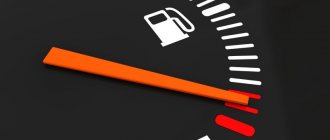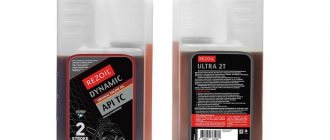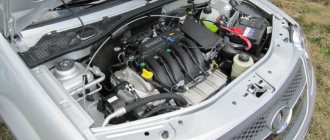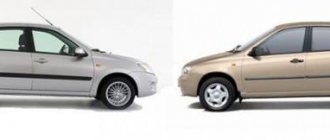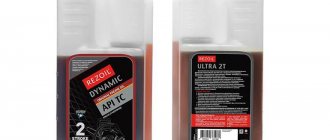Let us remind fans that the Lada Largus is a small-format universal “state car”, which was developed by AvtoVAZ with the direct participation of specialists from Renault-Nissan. This is reflected in the appearance of the car, since it is a derivative of the popular modification of the Dacia Logan MCV. The positive aspect of the universal “Russian” is its adaptability to domestic road conditions. This car can please you with its spacious interior, modern body design and spacious luggage compartment. It is these qualities that today form the basis for the priority of a car over the category of practical owners.
You should not ignore such a relevant indicator as gasoline consumption. In the Lada Largus station wagon, this parameter directly depends on the power plant option. Traditionally, driving style also makes a special contribution to the level of consumption.
The engines of this domestic car
For the power units that AvtoVAZ kindly equips its station wagons with, the developers used 4-cylinder blocks. The working volume of all “fiery hearts” is 1.6 liters.
The following motor versions exist:
- “K7M” is a unit with a 1.6 8-valve head design and is capable of producing 84 horsepower. The engine is produced at the Romanian branch of Automobile Dacia, owned by Renault.
- "K4M" - version 1.6 16 valves, produced at the European plant "Renault Espana". The unit's power rating reaches 105 hp. With. Also, an analogue of this motor is produced in the domestic division of OJSC AvtoVAZ. It is this option that ensures compliance with the EURO-5 regulations, although it has slightly lost its potential in performance (power – 102 hp, and torque – 145 N*m).
- The engine is from VAZ (code - “11189”), which has a traditional design with a 1.6 8-valve head and can generate a power of 87 hp. With.
Let us repeat that gasoline consumption directly depends on the engine version.
Lada Largus 1.6 (90 hp) 8 cells.
From the very beginning of production, cars were equipped with 90-horsepower gasoline engines with a volume of 1.6 liters. With such an engine you can accelerate to a maximum of 165 km/h with a torque of 128 Nm. It is also mated to a five-speed manual transmission.
Reviews about the consumption of Lada Largus 1.6 (90 hp)
- Grigory, Sochi. I'm a little disappointed with the purchase, to be honest, I expected more. I have a Largus 2015, 1.6, manual transmission. Inside, the electronics are completely old-fashioned, although what can you expect from your native AvtoVAZ? And gasoline consumption is high, up to 13 liters in the city.
- Andrey, Petersburg. Lada Largus 2014, 1.6, 90 hp. Surprisingly, this is not a bad option for a large family. Good roominess and handling, you can load it to capacity and drive comfortably. On country roads it consumes 8-9 liters, in the city 11-12 liters.
- Timofey, Syzran. I often have to travel long distances, and the Lada Largus helps me out a lot. On the highway it behaves perfectly, nothing bothers you. The power of the 90-horsepower engine is enough for comfortable movement. At the same time, I consider consumption outside the city to be within 8-8.5 liters as normal.
- Evgeniy, Moscow. I bought a Lada Largus with a mileage of 12 thousand kilometers a year ago. For some reason, during this time all the chrome peeled off. The power of 90 “fillies” is enough for the city, but on the highway you want more. Consumes up to 12 liters in the city in the warm season.
- Leonid, Tomsk. Lada Largus combines the functions of transporting passengers and cargo, and, if necessary, can turn into an SUV. 90 horses pull out with dignity on any terrain. Consumption is within normal limits: 9 liters highway, 12 liters city.
- Gennady, Orenburg. Lada Largus 2013 was purchased for family trips and work occasions. It handles well in the city and has plenty of power. The only drawback is the large gaps, due to which all the dust ends up in the cabin. Average consumption is 10 liters.
- Ruslan, Sevastopol. Lada Largus 2014, 1.6 (87 horses), MT. I bought it exclusively for work. If no problems are found on a suburban highway, then in the city its size is a bit of a hindrance. And the consumption is corresponding: 8-13 liters.
- Vladislav, Irkutsk. Lada Largus is used as a work car, and performs its functions one hundred percent. The car is 2014, 1.6 engine, manual. Interesting in appearance, roomy inside, good steering response, I'm happy. In the city, gasoline consumption can reach 11-12 liters, on the highway no more than 8.5 liters.
Other cars: Citroen Berlingo fuel consumption owner reviews
Let's consider the option with the K7M engine
LADA Largus with this version of the engine can boast a speed rating of 155 km per hour. Acceleration dynamics are not the strong point of this modification, because the first “hundred” is “exchanged” after 16.5 seconds. Fuel consumption regulated by the manufacturer is:
- for the urban cycle, the fuel consumption rate is at least 12.3 liters;
- on country roads the fuel consumption rate is about 7.2 liters;
- in mixed mode - approximately 7.5 liters.
Lada Largus 1.6 (105 hp) 16 cl.
The last in the line of power plants of the Lada Largus is a 1.6-liter engine with a power of 105 hp, which also runs on gasoline. Torque of 148 Nm makes it possible to accelerate to 183 km/h. The engine is equipped with a five-speed manual transmission.
Reviews about the consumption of Lada Largus 1.6 (105 hp)
- Maxim, Kyiv. I am the owner of a Lada Largus built in 2014, 1.6, manual transmission. I have a large family, according to the budget it was quite possible to buy a new car, we settled on this cruiser from our native AvtoVAZ, and did not regret it. There has never been a time when we didn’t take something due to lack of space. His appetite is not very large, 9.5 liters on average.
- Yakov, Moscow. I have a Lada Largus 2013, 1.6, 105 hp, manual transmission. For me, the downside is the soft suspension, I like it harder, but this is a personal opinion. But the car is quite good, with a reasonable appetite. In the city it takes 11-12 liters, on the highway 8-9 liters.
- Stanislav, Alushta. In terms of price/quality ratio, the Lada Largus is completely worth the investment. After a year of ownership, I can say that I am not satisfied with the sound insulation and the large amount of dust in the cabin. But these problems are easily solved. It consumes fuel in normal sizes - from 9 to 12.5 liters.
- Roman, St. Petersburg. Lada Largus 2013, bought new, has already driven more than 55 thousand km. I use it as a work vehicle and transport various loads. Everything is fine, so far there have been no breakdowns, we can thank the designers. Gasoline consumption is 7-10 liters.
- Andrey, Ufa. With the birth of my third child, the question arose about buying a fairly spacious car, the Lada Largus caught my eye, we tried it and liked it. We took the 2015 model with maximum engine power. In the city you can feel the size, but on the highway it’s simply beautiful! Consumes an average of 9 liters of gasoline.
- Igor, Yekaterinburg. I’ve had the Lada Largus for two years now, so far I can’t say anything bad, it’s even somehow strange, it seems to be a domestic car, but I’m happy with everything. After the first maintenance I can say that maintenance is a bit expensive. It seems to me that consumption of 12.5 liters in the city is a lot.
- Denis, Omsk. I have a Lada Largus 2014, 1.6, 105 horsepower, manual. Excellent spaciousness, obedient steering, good cross-country ability. Thanks to its high ground clearance, it behaves like an SUV. Fuel consumption is on average 9 liters.
- Alexander, Moscow. I got Lada Largus as soon as there was a new addition to the family. A good investment considering the package included. I have enough of everything, both power and dynamics. But there are problems with the foglights; they don’t light up at all. On average it consumes 9 liters of fuel.
Other cars: VAZ 1111 fuel consumption reviews
Real fuel consumption on Largus
Practice shows that the indicated indicators of the Lada Largus can differ significantly, in most cases upward, especially on the 1.6 16-valve engine. This circumstance is influenced by factors such as:
- the mode in which the car was run in;
- driving style (aggressive style predictably increases consumption levels);
- the use of additional equipment by the owner of the Lada Largus, especially the climate system, which increases the load on the power plant (remember that the turned on air conditioner can increase the consumption rate to approximately 1 liter per 100 km of distance traveled);
- malfunctions directly in the power unit;
- use of low-quality fuel;
- operation in winter conditions, especially without the ability to sufficiently warm up the unit.
This video shows changes in fuel consumption of the Lada Largus in real driving conditions:
Also, the level of consumption can be affected by the flow of cars itself, because frequent jerks in traffic jams contribute to increased consumption.
Renault Duster timing belt replacement
Rear bumper Renault Duster
Compare Lifan x60 and Renault Duster
Fuel level indicator scale
| Author: G.V.G. Published: 1972 days ago (May 4, 2016) Logbook: Lada Largus 7 seats equipment 02D Category: Uncategorized | +23↑ Votes: 23 |
I have always wondered how many liters of gasoline in the tank correspond to each “stick” on the fuel gauge. Through the test mode of the instrument panel, I “caught” all the transient modes of ignition and attenuation of the “sticks”. Of course, more than 50 liters is not taken into account. The light comes on when there is 7 liters left. Well, in general, what I got on my deluxe, by the way, on the Internet I saw the same detail for Logan, and so, they do not match with Largus. The number on the left shows with what amount of gasoline the stick is lit, on the right until the amount of gasoline the next “stick” is not yet ignited.
← Silicone case for signaling | Boxes for luxury seats, or… →
Create your own logbook, and you will be able to share with forum members your opinion about Largus, useful developments, installed additional information. equipment and tuning, trips and travel! To create a logbook, you must register on the site.
Popular in in-flight magazines
DRL Traveling on Largus Fuel consumption Armrest Mileage Discs Radio To1 First impressions Buying Largus Electrics Covers for Largus Bumper net Modifications HBO Speakers Rear view camera Wipers Interior lighting Brake light Tuning Tires and wheels Check valve Tuning lights Noise insulation Winter tires Rugs Largus DVR Rki-19 Winter operation Roof box PTF Tail lights Izhevsk Car audio Injectors Mudguards Washer reservoir Hood stops Low beam lamp Installing a cabin filter Parking sensors Thresholds Lada Largus LED Carpet covers Floating idle speed Trunk lighting Tinting Trunk shelf Trip to the sea Hood seal Accident Owner's review Fender liners Walkie Talkie Additional Socket Eyeglass case Replacement 5th gear
Comments (26)
| Triathlon 4 May 2021 at 20:05 +4 |
| The numbers in the table confirm my subjective observations that as the fuel level in the tank decreases, the “sticks” of the UUT begin to go out faster. |
|
| Alexey May 4, 2021 at 10:17 pm 0 |
| Plus, I was always tormented by the question of how much fuel was left on the sticks |
|
| Evgeniy Minsk May 4, 2021 at 10:44 pm 0 |
| So what is the volume of the tank? 57 l? |
|
| GVG May 4, 2021 at 10:53 pm +2 |
| 60-65 liters, depending on patience, pour slowly |
|
| LarqusMen585 May 4, 2021 at 11:16 pm +1 |
| not 60, but 65 and above…. I’ll tell you about the reserve light - it came on, I stopped, checked in the test = showed 8 lit (although I believe there are errors) |
|
| GVG May 5, 2021 at 00:51 0 |
| it lights up at 7 liters, and does not go out; if the level rises until you turn the ignition off/on, it does not light up immediately; there is some delay. I can’t say about 65 and above, I didn’t pour it with a measuring cup, but it’s realistic to pour 60-65. |
|
| LarqusMen585 May 5, 2021 at 07:12 +1 |
| You don’t need any measuring cups/beakers - you drive up, look at the remainder in the tank, calculate (assuming that the tank is 65 liters), order until it’s full, pour (push)….Usually I pressed in 65 liters, sometimes more got in (about less, no idea. . and talk)…….- My next trip (March 2016) The rest -
The image has been reduced. Click to see original. I pressed so much-
The image has been reduced. Click to see original. …… Previous trip-
The image has been reduced. Click to see original.
The image has been reduced. Click to see original. everything fits without beakers..... in March I really doused the car with a little bit. |
|
| GVG May 5, 2021 at 08:57 0 |
you yourself say “65 and you can wet yourself” so it turns out 60-65 is guaranteed  |
|
| LarqusMen585 May 5, 2021 at 8:30 pm +1 |
| Well, if so, then definitely! |
|
| 2 brother May 7, 2021 at 06:37 +1 |
| It’s amazing where your technology has come, but ours is more vintage
|
|
| Andrew46 May 5, 2021 at 06:03 +1 |
| In Belarus you have a different liter. I already wrote about this. With a remainder of 6 liters, you barely filled 45 with 3 cut-offs, we have the same flow and without cut-offs. You need to check it with a beaker. |
|
| Dima May 5, 2021 at 01:25 pm 0 |
| Unfortunately, my 11 liter fuel remaining light comes on...why is that interesting? |
|
| GVG May 5, 2021 at 02:41 pm 0 |
| why did they decide this? |
|
| Dima May 6, 2021 at 03:54 pm 0 |
| Why? yes, as if the lamp had come on, I stopped on the horizontal surface, waited 5-7 minutes (on purpose) to eliminate bumpiness, etc. I switched the tidy into test mode. The tidy showed 11 liters of residue. Then it gets more interesting - I remove the terminal with the battery, I put it back on the dashboard, one bar is on again. I drive a short distance (maximum 500 meters) and the fuel remaining lamp comes on again. I stop, there are still 11 liters in the tank, in test mode |
|
| GVG May 6, 2021 at 6:43 pm 0 |
| The lamp comes on when the FLS shows 7 liters, and does not go out again, i.e. if you were driving slightly downhill and for some time (I don’t know how long either, but maybe a few seconds are needed for the FLS to constantly show 7 or less liters) the tidy saw 7 liters, it will light up the light, when the level levels out the light will continue to burn, at how many liters it goes out, I don’t know. |
|
| LarqusMen585 May 6, 2021 at 08:33 pm +1 |
| I haven’t looked into it much, but I think 11L is a lot for a reserve. |
|
| GVG May 13, 2021 at 7:02 pm 0 |
| Today the light came on again, in general its operating algorithm is quite simple, as I said, the light comes on when the last division goes out, the last division goes out when there are less than 7 liters in the tank according to the FLS. In general, the lamp lights up, in test mode it shows on a slope of 10 l and both the last division and the lamp are on, in normal mode the last division does not light up, but the lamp is on, it seems that in test mode the lamp works according to the general algorithm, i.e. In order not to take into account fluctuations in gasoline in the tank, the indicator in normal mode has greater inertia, i.e. In order to turn off the lamp, I would have to stand for a while so that the last indicator would light up. In general, the lamp lights up at 7 liters or less according to the FLS |
|
| 2 brother May 7, 2021 at 06:38 0 |
| Plus for the research done |
|
| alexei May 7, 2021 at 06:51 0 |
| By the way, if you conduct the same research on the second scale (OZ), the result will be much more interesting and very diverse. |
|
| GVG May 7, 2021 at 08:16 +1 |
| It’s easier here, most likely it coincides with Logan, at least 50 and 80 degrees, I looked at the ELM327, I can’t check the rest of the temperature values, sorry
|
|
| alexei May 7, 2021 at 08:39 0 |
| Only at first glance, I have 2 sticks - 51* and 4re - 66* (I checked both MK and OD)! If you collect all the statistics, then But here one specific Largus will not do. |
|
| GVG May 7, 2021 at 08:43 0 |
The image has been reduced. Click to see original. but it all depends on the version of the tidy software. I think
OPAV can easily dot the T’s by just looking at the tidy software that is installed on Largus |
|
| Dima May 7, 2021 at 1:34 pm 0 |
| Four “sticks” for me (personally) light up at 70 degrees. Elm + multitronics. The rest of the data is the same |
|
| GVG May 7, 2021 at 6:38 pm 0 |
| Anything is possible, it was a long time ago, I don’t remember, I need to check again |
|
| Ваdemus May 9, 2021 at 05:39 pm 0 |
| If you look at the ELM, then I have 2 sticks at 53°, and four at 82°. |
|
| Dima May 13, 2021 at 09:45 pm 0 |
| circled, how is it calibrated? |
|
| Add a comment | RSS comments feed |
Additional comments:
Fuel consumption on the highway
To achieve a certain savings, you must adhere to the speed limit indicated by state regulations. The formation of actual fuel consumption occurs under various driving modes, during which the speed can increase from 30 km per hour to a significant 130 km per hour. The average speed for LADA Largus is approximately 77 km per hour.
Important! Based on the analysis, based on numerous reviews of Largus owners, a conclusion can be made regarding average fuel consumption. So, for this particular station wagon it is about 7.2 liters.
Real fuel consumption of Largus in urban conditions
If the driver has set himself the goal of determining the real level of fuel consumption of his LADA Largus station wagon, then for the purity of the experiment he will need to resort to the following measures:
- deliberately getting into traffic;
- be in rush hour traffic;
- stand idle at traffic lights or find a street with the maximum number of such control devices;
- Do not forget about the need for a constantly running air conditioner.
Such driving conditions, according to accumulated statistics, can lead to a real level of urban consumption equal to about 13.3 liters per “hundred” of mileage.




